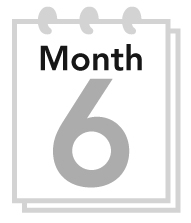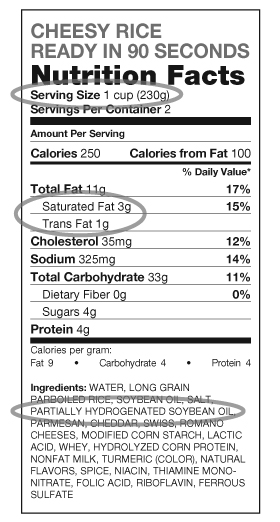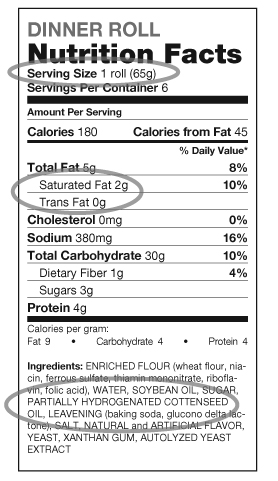
Many dieters find that weight loss stalls after about six months, so here we address the dreaded plateau. But first, we give special attention to the types of fats in your foods—again to make your diet plan work for the long term. Pay attention to more tricky food labels!
For the Long Haul: Limit Saturated and Trans Fats
There’s no need to drastically limit the amount of fat you eat. Fat enhances the taste and mouth-feel of your food, and it helps you absorb fat-soluble nutrients. Having a little bit of fat with your salad, for example, helps you absorb some of the nutrients in your greens and tomatoes.
The problem with fat is that it has a lot of calories—more than twice as many as in carbohydrate and protein, so watch your total fat intake to keep calories in check. The other problem is that two types of fats (saturated and trans fats) likely raise your risk of heart disease, cause unwanted inflammation linked to type 2 diabetes, and lead to a host of other health problems. These are the ones to avoid. According to the Dietary Guidelines for Americans, 2010, we consume too much saturated and trans fats. To trim your intake, indulge only occasionally in small amounts of pizza, full-fat cheese, and other full-fat dairy, baked goods, sausage, bacon, hot dogs, ribs, poultry skin, fatty meats, fried foods, butter, stick margarine, shortening, and other solid fats. In their place, enjoy moderate amounts of foods containing good-for-you fats like nuts and seeds, nut butters, vegetable oils, and avocado. At home, cook with canola, soybean, or olive oils instead of butter or lard. Use a low saturated-fat soft spread for toast. Slip a slice of avocado into your sandwich instead of cheese, and make a sandwich with almond butter or peanut butter instead of bologna. In restaurants, order a small baked potato instead of French fries. At the supermarket, check the Nutrition Facts panel for both saturated and trans fats. Additionally, look at the ingredients list to avoid groceries containing partially hydrogenated oils, a telltale sign that the product contains trans fats. Look at the two sample food labels on the following pages and see how simple it can be to identify these fats and the fat-providing ingredients.


The cheese is the likely source of most of the saturated fat, and the hydrogenated soybean oil provides the trans fat. If you ate just one cup of the prepared rice, you would have eaten 3 grams of saturated fat and 1 gram of trans fat. Some people will eat the entire package (2 servings), logging 6 grams of saturated fat and 2 grams of trans fat. Remember: always look at the serving size first because every other number relates to that amount of food.
You might think that these rolls have no trans fat. Not so fast. Yes, the Nutrition Facts panel clearly says that one roll has 0 g of trans fat. Though legally accurate, this is not technically accurate. Manufacturers are allowed to claim that any food containing less than 0.5 grams of trans fat has 0 grams of trans fat. Therefore, even for foods that appear to be trans-fat free, read the ingredients list. In this case, you’ll find partially hydrogenated cottonseed oil, a source of trans fats. All partially hydrogenated oils will provide at least a trace amount of trans fat. If you eat a roll or two and perhaps a serving or two of a soft spread also made with partially hydrogenated oils and some packaged foods earlier in the day, all of those trace amounts can add up to more than your daily limit. Do your best to avoid everything with partially hydrogenated oils. Claims like “Low Fat” or “Trans Fat Free” on the packaging are enticing, but it’s the Nutrition Facts panel and the ingredients list that give you the real information.
How Much Is Too Much?

Seek Out the Good-for-You Fats
Don’t forget to include sources of omega-3 fatty acids. There are two types of these health-boosting fats: those found in some fish and those found in some plants. Both types are linked to a healthy heart. Research suggests that the omega-3 fats in fish may also promote brain and eye development in infants and children, improve the cognitive function of the elderly, and lessen the symptoms of inflammatory diseases such as arthritis, asthma, and ulcerative colitis. Choose foods with omega-3 fats often, such as:
• Walnuts, ground flaxseed, tofu, soybeans, canola and soybean oils, bluefish, herring, lake trout, mackerel, salmon, sardines, tuna
Other good-for-you fats include the monounsaturated fats found in nuts, avocados, olive, soybean, and canola oils, and olives. Be very careful not to add these high-fat foods to your diet without eliminating other foods. You’ll likely gain weight without replacing one food for another. A good swap is trading cheese for avocado or chips for nuts. Use them sparingly, however.
Most successful dieters hit the dreaded weight-loss plateau eventually. Frequently, it occurs after about six months of weight loss or when the individual has lost about 10% of his or her starting weight (about 20 pounds for someone starting at 200 pounds). As hugely frustrating as the plateau is, it’s not the time to throw in the towel. A lot of people get so frustrated with the lack of weight loss that they just quit trying or they make radical diet changes, mistakenly believing that it’s necessary to “shake up the body” to start losing again. Your body doesn’t need shocking or shaking up. What has happened is the new, smaller you burns fewer calories than the old, larger you. If it feels that you have to cut back even more than before only to lose weight at a slower pace or not at all, you are correct. It seems like a dirty trick, but it’s just the way the body works. Instead of letting this break your motivation, increase your focus to break through the plateau.
• Go back to the basics. When you first started this weight-loss plan, you probably took more care to keep records, measure your food, and plan ahead than you do now. Get back to those first behaviors. If your measuring cups are collecting dust, you might be surprised that your ½-cup serving of pasta has blossomed to ¾ cup.
• Make a date with yourself. Spend some quiet time reflecting on why you have worked so hard and why you want to continue your weight loss. Grab your Motivation Kit, and review your list of reasons to lose weight. Add more reasons as you think of them.
• Visualize the result. Spend a couple minutes each morning seeing yourself looking and feeling fabulous.
• Make two or three food swaps every day. For example, have an open-faced sandwich for lunch instead of your typical sandwich or trade in your 6-ounce juice glass for a 4-ounce glass. Or, consider having a piece of fruit instead of juice.
• Start every lunch and dinner with nonstarchy vegetables. Broccoli, zucchini, cabbage, tomatoes, and more are low in calories and can help take the edge off your appetite before you dig into the higher-calorie foods.
• Watch your alcohol intake. Not only does the alcohol have calories, but drinking might weaken your resolve to cut back on high-calorie food.
• Rev up your workout. If you aren’t already lifting weights or performing some other type of resistance exercise, get started. Next, add intervals to your aerobic exercise routine. See Weeks 1, 3, 4, 6, 7, and 12 to review the information about exercise. Go on a workout tour by visiting a new class at a gym every day or every other day for a week.
• Wear a pedometer. If you haven’t yet bought one or if you’ve pushed yours into the back of a drawer, clip on a pedometer and challenge yourself to more and more steps each day. See Week 1 for information about selecting and wearing a pedometer.
• Reassess your goal. This is a great time to examine your weight-loss goals. Maybe this is your healthy weight. Or maybe this is the weight you should maintain before attempting weight loss again in a few weeks or months or even years. If so, work on keeping your weight steady, which will require continued effort. Whatever you do, don’t go back to old habits. Old habits will bring back the less healthy you.
 Continue the following goals: _____________________________________________________________
Continue the following goals: _____________________________________________________________